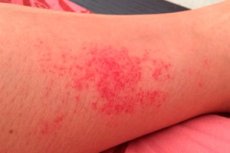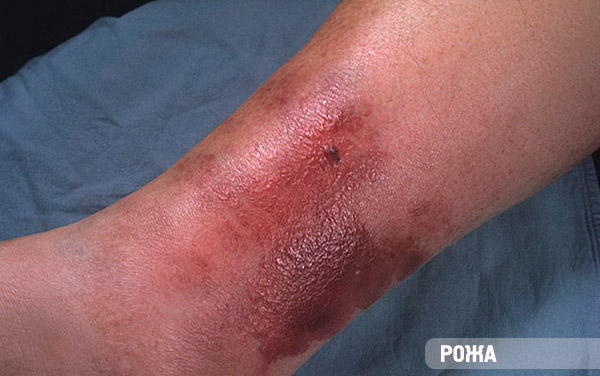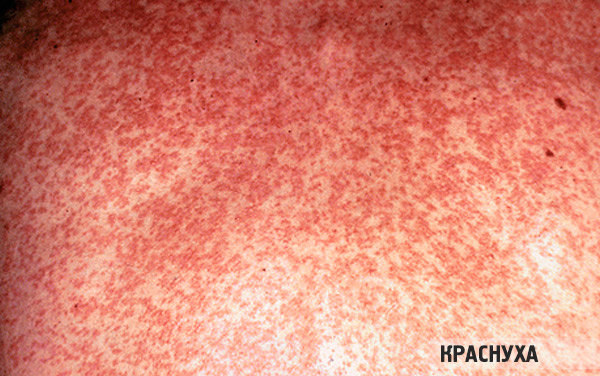Medical expert of the article
New publications
Red spots on the legs of an adult and a child
Last reviewed: 06.07.2025

All iLive content is medically reviewed or fact checked to ensure as much factual accuracy as possible.
We have strict sourcing guidelines and only link to reputable media sites, academic research institutions and, whenever possible, medically peer reviewed studies. Note that the numbers in parentheses ([1], [2], etc.) are clickable links to these studies.
If you feel that any of our content is inaccurate, out-of-date, or otherwise questionable, please select it and press Ctrl + Enter.

Human skin is an organ that protects the body from the outside from pathogenic microorganisms, temperature changes, aggressive substances and other irritants. One of the signals that something is wrong with the body is red spots on the legs. In adults, they are most often associated with the following diseases:
- Allergic reactions – occur after exposure to a certain allergen. These can be food, cosmetics, medications, clothing, and much more. Redness is often accompanied by itching, and in some cases, peeling of the affected tissues. The condition normalizes after the allergen is eliminated.
- Fungal infections - mycoses manifest themselves with pathological symptoms on the feet and shins. The rash peels, itches and is covered with small cracks.
- Psoriasis - changes are located on the knee joints. They are rough and cause severe itching. The main feature of this pathology is that the spots periodically appear and disappear.
- Pink lichen is another fungal disease, but it is not contagious. It occurs in adults with weakened immune systems. Red, flaky lesions with slight itching form on the legs.
- Eczema is a skin pathology with an acute course. Rough papules and blisters form on the body. Most of the rashes are in places where the body comes into contact with clothing, for example, in the armpits, between the legs.
- Atopic dermatitis - flaky rashes, slightly raised above healthy tissue and have a blurred outline.
- Varicose veins - occur due to disruption of normal blood flow through the veins. At the initial stage, they are manifested by hyperpigmentation and rashes.
- Erysipelas - appears due to streptococcal infection. The changes have a pronounced red rim, the body temperature is elevated, there is general weakness and sweating.

- Syphilis - multiple hyperemic areas form on the legs and other parts of the body. There are no other complaints about changes in well-being.
Treatment begins with diagnosis and confirmation of the cause of the disorder. For example, if the problem is related to a fungal infection, then antifungal agents and general strengthening therapy are prescribed.
Red spots on the legs of a child
Various red spots on a child's legs most often occur for the following reasons:
- Rubella - red marks not only on the legs but also on other parts of the body. The body temperature is elevated, the rash is very itchy.

- Allergic reaction – may occur to body care cosmetics, new laundry detergent, insect bites, sudden temperature changes. In some cases, it is accompanied by itching, peeling, and the appearance of blisters with liquid contents.
- Enterovirus infection - the changes have a clear red outline and itch a lot. They can appear not only on the legs, but also on other parts of the body. They are often accompanied by fever, blistering rashes on the mucous membranes, bouts of nausea and vomiting, coughing, and loose stools.
- Measles - initially, defects form on the face, and then on the legs, merging with each other. The child has a high temperature, runny nose, swollen eyelids, increased lacrimation.

- Meningococcal infection is a serious disease that can be fatal. It begins with a short runny nose, after which pathological skin reactions appear on the legs and buttocks. Against this background, the body temperature rises. Gradually, the rash spreads to other parts of the body.
- Scarlet fever is caused by the same bacterial pathogen as tonsillitis. Tissue changes appear on the 2nd-3rd day of the disease, forming on the legs, in the groin, on the cheeks and on the sides.
- Ringworm - spots of various shapes, can peel and itch. The disease most often occurs due to contact with infected animals.
In addition to the above reasons, rashes on a child’s legs may be associated with wearing uncomfortable clothes or shoes, problems with the digestive system, pancreas, liver or kidneys.
Red spots on legs in pregnant women
During pregnancy, many women face various dermatological problems, which most often appear on the limbs, face and abdomen. Red spots on the legs of pregnant women not only have an unattractive appearance, but can also cause painful sensations. The appearance of a rash in most cases is associated with hormonal changes in the body. Most often, skin changes make themselves known in the third trimester of pregnancy, less often in the early stages.
Let's look at the main causes of dermatological disorders in pregnant women:
- Allergic reactions – many women begin to suffer from allergies during pregnancy. This is due to the fact that during the period of expecting a baby, the mother's body becomes very sensitive to any irritants. Anything can cause a rash – from food to animals or household chemicals. In some cases, the skin changes that appear are accompanied by itching and peeling.
- Prickly heat – usually appears in the summer. Red rashes appear not only on the legs, but also on the stomach, chest, and arms. The disorder is accompanied by severe itching. This phenomenon is associated with increased sweating, wearing hot, synthetic or tight clothing, and poor hygiene.
- Infectious diseases – during pregnancy, the body is weakened, so it poorly resists various infections. This can be measles, rubella, chickenpox and other pathologies.
- Disturbances in the functioning of internal organs - in some cases, rashes on the legs are associated with problems with the functioning of internal organs due to increased stress. Most often, these are malfunctions of the liver and gallbladder.
At the first symptoms of skin changes, you should visit a doctor and undergo diagnostics. Based on the results of the examination, the doctor will select the most optimal and gentle treatment plan.
Red spots on legs after childbirth
Many women face such a problem as red spots on their legs after childbirth. In most cases, the unpleasant condition is associated with recent hormonal changes, i.e. indicates a vitamin deficiency of the skin.
The skin is the largest organ of the human body, therefore it is very sensitive to the deficiency of vitamins and microelements. This manifests itself in various rashes, increased dryness, peeling, itching. For the treatment of vitamin deficiency, a balanced diet and taking vitamin preparations are recommended. This will restore the epidermis and improve the functioning of all organs, which could be disrupted during pregnancy.
In addition to vitamin deficiency, skin disorders after pregnancy may indicate fungal infections, vasculitis, the development of diabetes, varicose veins. Also, allergic reactions to cosmetics and household chemicals, food products, or wearing tight shoes should not be ruled out.
Red spots on the legs of an elderly person
Our skin is constantly renewed, new cells are formed in the lower skin layer and gradually replace the upper epidermis. As the body ages, this process slows down, the elasticity of the skin decreases, it begins to sag, wrinkles and other age-related changes appear.
Red spots on the legs of an elderly person are not uncommon. Most often, they are associated with the following reasons:
- Senile purpura - in old age, the epidermis becomes thinner and is easily destroyed. Because of this, any bruises, and sometimes tissue compression, lead to the destruction of blood vessels and the appearance of red spots. Recovery is extremely slow.
- Xerosis (asteatotic eczema) is eczema from dehydration. Dry, inflamed, flaky patches form on the legs and other areas of the body.
- Infectious and parasitic lesions – scabies and ringworm are very often diagnosed in elderly patients.
- Pigment changes - the appearance of such spots is called age spots. They are formed due to damage to the skin by aggressive ultraviolet radiation. If left untreated, they can become covered with painful crusts
- Non-cancerous skin lesions – seborrheic keratosis, cherry angiomas (Campbell-de Morgan syndrome), sebaceous hyperplasia.
- Skin cancers – the most common are basal cell carcinoma and squamous cell carcinoma. These pathologies arise due to prolonged exposure to solar radiation.
- Stagnation dermatitis - in some elderly patients, due to impaired blood circulation in the vessels of the lower extremities, that is, on the legs around the ankles, a red rash appears. This pathology requires treatment, as it can develop into ulcers.
- Allergic reactions are most often reactions to medications. In addition to rashes, itchy blisters with liquid contents may form on the body. For treatment, it is necessary to identify the drug that provokes the changes and stop taking it.
In old age, the body requires special care and attention. To reduce the risk of various rashes, it is necessary to regularly use moisturizing creams and lotions, avoid frequent hot baths, use only mild soap, and promptly consult a dermatologist if any changes are detected.

